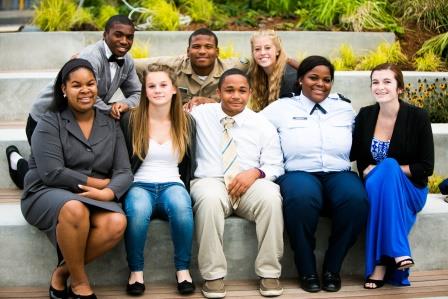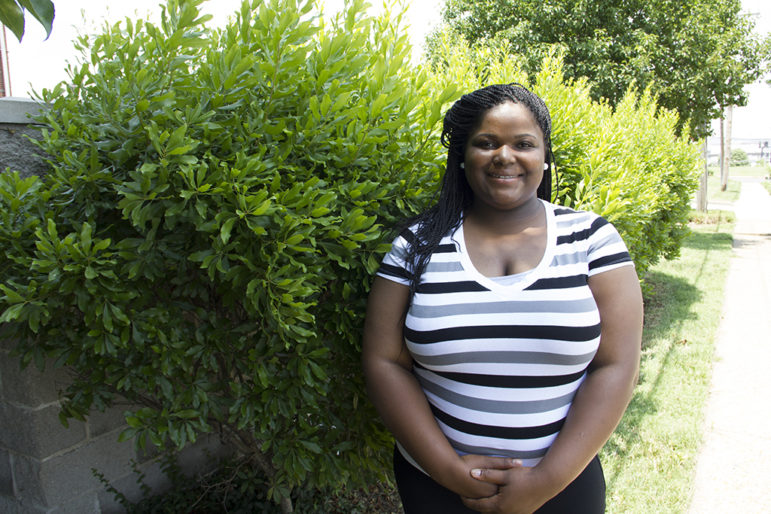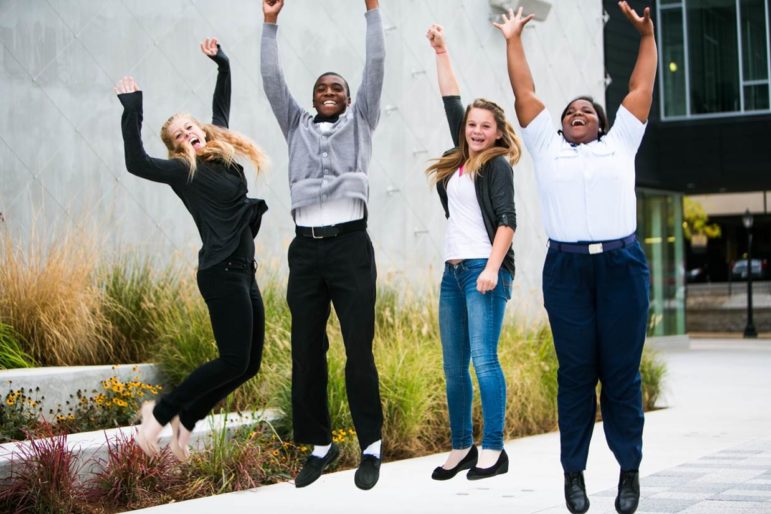
Romi Hemphill was in the sixth grade when she got her first taste civic leadership through the Wyman Center’s Teen Outreach Program.
“It made me a better person,” Romi said about the program, which she continued to participate in through high school. “It made me stronger.”
It also helped her discover a career goal. She’s now pursuing a certified nurse assistant degree at Southeast Missouri State University in Cape Girardeau, Missouri.
Romi’s experience in the Teen Outreach Program engaged her in her community.
Not only does youth civic engagement benefit the community, but it has great benefits for the young people involved.
Defining civic engagement
Civic engagement can refer to a range of activities from community service to political activism. The Forum for Youth Investment lists five general categories of civic engagement: community service/service learning, leadership development, governance (as in youth councils), political advocacy, and peer and community education.
Romi met after school once per week with a group of students and an adult facilitator at a community center in the Near Southside of St. Louis.
The group planned activities: They took care of little kids during monthly parent-teacher meetings at a nearby school. At times they created a mini-carnival for the kids with face-painting, cotton candy and snow cones.
The group maintained graves at a local cemetery in memory of an East St. Louis teenager who died and who had been in a Teen Outreach Program.
They visited patients at the American Cancer Society facility in St. Louis “to let them know we cared,” Romi said. The students even cooked for the patients.
Outcomes of the program
The Teen Outreach Program began as a pregnancy and dropout prevention program in St. Louis in 1978. In 2007 Wyman designed a model for national replication.
The program is used by numerous agencies and nonprofit organizations around the country, reaching 35,000 youth across the United States.
Organizations pay to get the curriculum and training.
Throughout the 1990s, a number of studies by University of Virginia psychology professor Joseph P. Allen and colleagues showed the program’s impact.
TOP participants are 53 percent less likely to become pregnant and 60 percent less likely to drop out of school, according to Wyman, a long-established youth development organization in St. Louis.
Based on surveys given by Wyman to teens at the beginning and end of the program in 2015:
- 98 percent or teens in the program are actively engaged in the community;
- 79 percent say they have the ability to effectively problem solve;
- 98 percent have not become pregnant or fathered a child;
- 99 percent moved to the next grade in school.
Significantly, researchers found that the community service part of the program is directly connected to its impact. The number of volunteer hours correlated with a reduction in problem behaviors among teens.
“The community and service learning piece … it is the area where the young people are really able to build a sense of efficacy,” said Christina Donald, senior director of partner services team, which manages the Teen Outreach Program for Wyman’s National Network.

Teens set goals and work to meet them, she said, with about 20 hours of service per year.
They feel: “I have something to contribute” and they have their voices heard, she said.
One of the key characteristics of TOP is that “young people have a lot of choice,” Donald said. They determine which project or experience to undertake based on what they are interested in.
Donald said the two other core components of the program are its curriculum and the positive support offered by adults.
The curriculum covers communication skills and assertiveness, understanding and clarifying values, relationships, goal-setting, decision-making, and adolescent health and sexual development. Students approach the topics through discussion and role-play.
Although pregnancy prevention is a main outcome of TOP, only about 15 percent of the curriculum involves sex education.
A range of benefits
More than a decade ago, the Forum for Youth Investment, a national nonprofit devoted to research, advocacy and policy-making on behalf of youth, pointed out four ways civic engagement in out-of-school time positively impacts young people.
It can:
- Lead to future civic involvement.
- Increase academic achievement and positive attitudes about school and work.
- Positively affect interpersonal relationships and social development. For example, young people who do service have a stronger sense of their ability to help others. They are also more likely to help their peers, act kindly toward them and appreciate cultural diversity, according to a 2004 brief by the Forum for Youth Development.
- Lower the likelihood of risky behaviors, as the Teen Outreach Program shows.
Why does civic engagement work?
Among researchers who have studied the impact of community service on youth are Miranda Yates and James Youniss. Yates is now executive director for strategy, evaluation and learning at Good Shepherd Services, a multi-service agency that works with young people in New York City. Youniss is a research professor of psychology at Catholic University.
Engaging in service gives youth a chance to experience a new role, Yates and Youniss wrote. Young people take on challenges and responsibility, and they report gaining confidence and “efficacy,” according to the researchers.
Students are able to use their own judgments, they said.
Service is a way young people develop self-understanding. They grapple with questions about meaning, according to Yates and Youniss, and develop a new sense of their role in the world.

Community service programs that are the most effective offer “intense experiences in which participants are given responsibilities and the chance to feel efficacious and social interactions, particularly with marginalized populations,” Yates and Youniss wrote
in their literature review “A Developmental Perspective on Community Service in Adolescence,” published in the journal Social Development in 1996.
More recently, Amy Syvertsen, a research scientist at the Search Institute in Minneapolis, has been seeking to understand how organizations can best promote civic engagement among youth. Syvertsen, is conducting a project, the Roots of Engaged Citizenship, with two colleagues. Out-of-school time programs can ask themselves the following questions, she said.
- Are kids being intrinsically engaged? Are they involved in something they are passionate about? Something they can give their full attention to?
- Are kids experiencing close connections with other adults that are pushing them? Are they experiencing challenge and support?
- Are kids engaged in sociopolitical discussions? Are they talking about inequities in the community? Are they talking about injustice? Are they talking about politics?
Intrinsic engagement, social relationships and discussion are the three important experiences, she said.
“In general, when those three things are happening in programs, we see high levels of civic engagement for young people,” Syvertsen said.
Discussion, action, deep support
Romi Hemphill remembers the discussions that took place in the TOP program. How should friends respond when a friend gets into trouble or runs away? Should they talk with adults about it?
The program helped Romi gain a sense of direction. She also got help applying for college.
“I really didn’t know what I wanted to do,” she said. But along the way “I figured out my career would be to help people.”
Romi had a lot to cope with during her high school years. Her father became seriously ill. Her cousin was murdered. Her entire family was devastated by her cousin’s death, she said.
Through these crises, the facilitators and students in the Teen Outreach Program had her back. The relationships she developed were a crucial support.
“I know a lot of kids who do not get real, true love from their family,” she said. But she felt it from the adult leaders, she said, and they pushed her to think about what caring really means.
TOP provided positive adult relationships and a forum for discussion, all while students planned and carried out valuable community service.
“[Community service] is so powerful,” Donald said. “It’s a turning point for many of our young people.”
“They feel connected back to the community … and build on skills they may not even realized they had,” she said.































